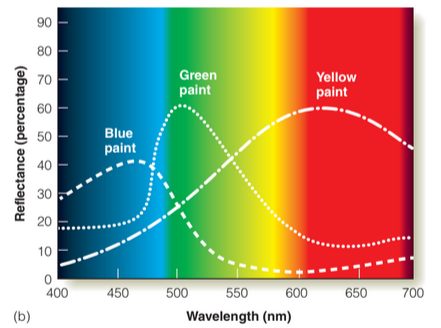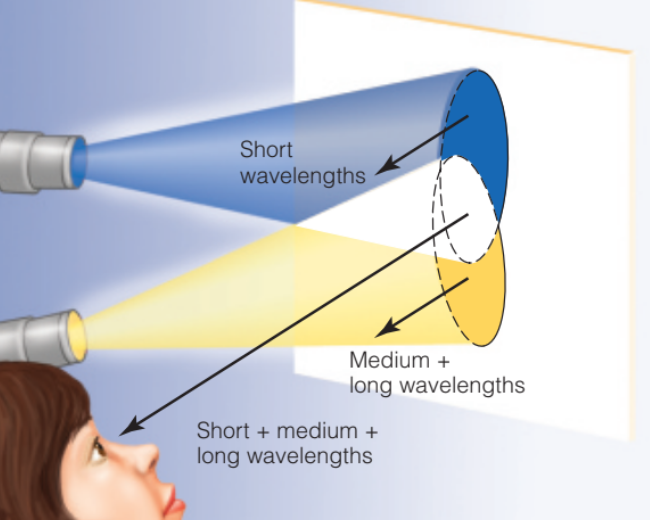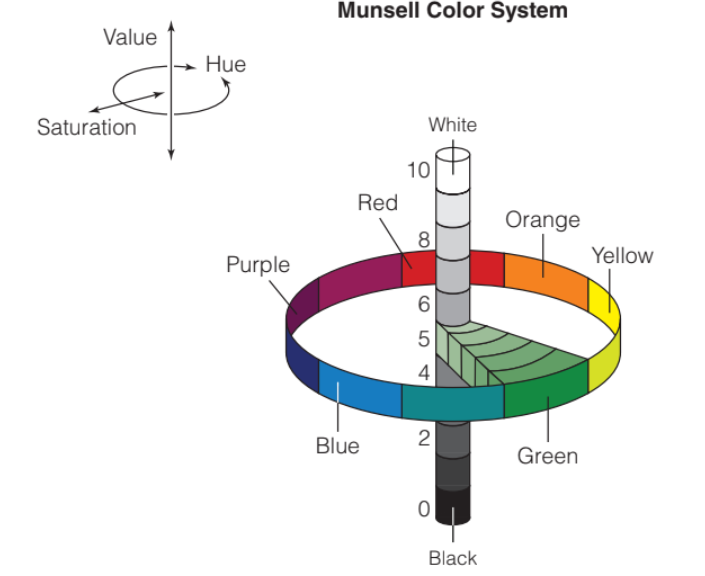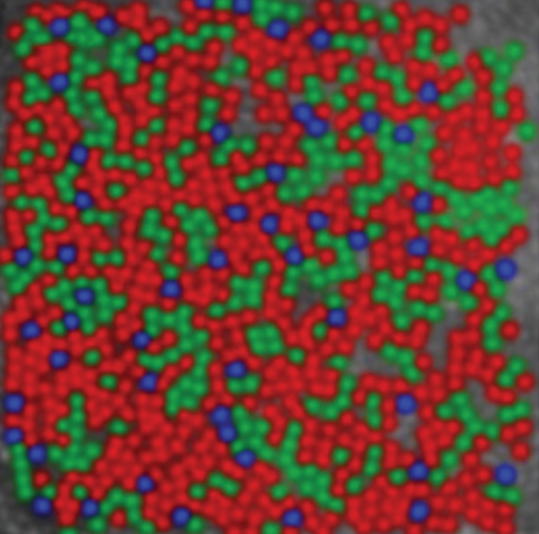Color + vision perception
1/42
Earn XP
Description and Tags
Asynch lecture 10/14/2025, pgs 200-210
Name | Mastery | Learn | Test | Matching | Spaced |
|---|
No study sessions yet.
43 Terms
What are the chromatic colors? aka hues
Blue Green Red
What is Selective Reflection?
where colors (like chromatic colors) occur when some wavelengths are reflected more than others
Achromatic colors + how do they occur
White, gray, black
occur when light is reflected equally across the spectrum
How do we see certain wavelengths of lights?
We see whatever is reflected
What is selective transmission?
only some wavelengths pass thru object/substance
ex. for cranberry vs lemonade in bottle
How does mixing paints work
both paints still
absorb the same wavelengths they absorbed when alone, so the only
wavelengths reflected are those that are reflected by both paints in common.
Subtractive color mixture
what occurs when u mix 2 paints/color together. You subtract all wavelengths except the ones associated with mixed color (ex. blue and yellow stay for green)

Additive color mixture
Mixture of lights
What happens when you project blue and yellow light on a white surface?
The white surface absorbs all light
“all of the light that is reflected from the surface by each light when alone is also reflected when the lights are superimposed.”
so when you shine the blue and yellow (they reflect blue and yellow lights alone respectively that why we see blue and yellow), they both get reflected and you see a white spot!

Spectral colors are
the ones that appear on spectrum (ex. rainbow colors)
Non spectral colors are
opposite of spectral colors, don’t appear on spectrum bc they are a mix of the spectral colors
(ex. red + blue → magenta which is a non spectral color)
How do we perceive all colors when visible spectrum is only a few colors?
we have 3 perceptual dimensions
3 perceptual dimensions
hue
saturation
brightness (luminosity/value)
Saturation
intensity of color
Value/lightness
light-to-dark dimension of color
Color solid
a way to relate the 3 perceptual dimensions
this one is called Munsell color system jm

Trichromacy of color vision (Young-Hemholtz theory)
color vision depends on activation of 3 different receptor mechanisms
Color matching
A psychophysical procedure that proved this trichromacy theory
Given a reference light, and asked to match that wavelength using 3 RGB lights
3 RGB light = 3 receptor mechanisms w/ diff spectral sensitivities
Microspectrophotomentry
direct a narrow beam of light into
a single cone receptor of eye
How many types of cones are there?
3!
short wavelength pigment (S) absorbed maximally at
419-nm
the middle-wavelength pigment (M), at 531-nm
the long-wavelength pigment (L), at 558-nm
what’s special between L and M cones
There’s a large overlap!
Adaptive optical imaging
look into a person’s eye and take pictures that showed
how the cones are arranged on the surface of the retina.
creates cone mosaic images!

Aberrations
imperfections in eye’s cornea and lens which distort light on the way to retina
How do we know which receptor are signaled given a certain light?
Ex. for a blue (short wavelength) light, here’s a large response in S receptor, smaller response in M, and even smaller response in L
white = equal signaling in all receptors!
Metamerism
2 physically different stimuli are perceptually identical
Metamers
2 identical fields in color matching experiment
Why do metamers look alike?
The reason metamers look alike is that they both result
in the same pattern of response in the three cone receptors.
EXAMPLE
when the proportions of a 620-nm red light that
looks red and a 530-nm green light that looks green are ad-
justed so the mixture matches the color of a 580-nm light,
which looks yellow, the two mixed wavelengths create the
same pattern of activity in the cone receptors as the single 580-
nm light
Monochromatism
form of rare color blindness where they don’t have functioning cones, so they are only able to see through the rods
only needs 1 wavelength of light to match all others
Isomerization
when light is absorbed by the retinal part of the visual pigment molecule, retina changes shape
lower wavelgth of light isomerizes (more/less) visual pigment molecules?
More
Can change this relationship by adjusting intensity of the light
Principle of univariance
once a photon of light is absorbed by a visual pigment molecule,
the identity of the light’s wavelength is lost.
receptor doesn’t know wavelength of light absorbed, only the TOTAL AMNT that has been absorbed
Takeaways from monochromat experiment
can take any wavelength of light and match by adjusting it’s intensity
need more than 1 type of receptor to perceive chromatic color
Dichromacy
color vision with 2 pigments in retina
dichromats see chromatic colors, but can confuse some colors
Ishihara plates
a way to diagnose color deficiency

Unilateral dichromat
a person with trichromatic vision in one eye and dichromatic vision in another
we use this person to see what colors dichromat perceives compared to trichromat
they look through dichromat eye, see what color that is, and see what color it reports in the trichromatic brain
3 different forms of dichromatism
protanopia
deuteranopia
tritanopia
2 common kinds of dichromatism
protanopia and deuteranopia, inherited thru gene located on x chromosomeWh
y are males more susceptible than females to being dichromats?
they have XY vs XX, so stronger effect on males
Protanopia
missing long wavelength pigment
short wavelength light is blue, as wavelength is increased blue becomes less and less saturated until 492 nm where it’s gray (neutral pt)
Neutral point
when the person perceives gray
Deuteranopia
missing medium wavelength pigment
perceives blue @ short wvlgth
yellow @ long wvlgth
Neutral pt 498 nm
Tritanopia
missing short wvlgth pigment
blue as short wvlgth
red long wvlgth
neutral pt @ 570 nm
Anomalous trichromatism
another type of color deficiency
needs 3 wavelengths to match any wavelength
they mix it in diff and wrong proportions than trichromat and aren’t good at discriminating wvlgths that r close together